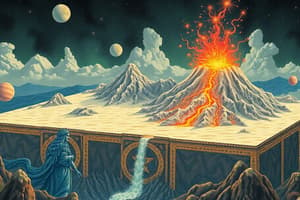Podcast
Questions and Answers
What is formed by molten rock cooling and hardening before reaching the earth's surface?
What is formed by molten rock cooling and hardening before reaching the earth's surface?
Intrusive volcanic features
What percentage of the earth's volume is made up by the mantle?
What percentage of the earth's volume is made up by the mantle?
82%
Which of the following is an example of an intrusive volcanic feature?
Which of the following is an example of an intrusive volcanic feature?
- A lava flow
- A sill (correct)
- A geyser
- A volcanic cone
What is the inner most layer of the earth called?
What is the inner most layer of the earth called?
Plate tectonics is the study of the earth's crust and how their movements affect rocks and landforms on the surface.
Plate tectonics is the study of the earth's crust and how their movements affect rocks and landforms on the surface.
Which type of plate boundary is characterized by moving plates that create new crust?
Which type of plate boundary is characterized by moving plates that create new crust?
The crust accounts for about 1/60 of Earth's volume.
The crust accounts for about 1/60 of Earth's volume.
Which of the following features is NOT associated with a convergent plate boundary?
Which of the following features is NOT associated with a convergent plate boundary?
Match the following types of rocks with their descriptions:
Match the following types of rocks with their descriptions:
What evidence supports the theory of continental drift?
What evidence supports the theory of continental drift?
Flashcards are hidden until you start studying
Study Notes
Volcanic Features
- Intrusive volcanic features arise when molten rock cools before reaching the surface.
- Magma creates pathways through weaknesses in the crust, causing it to widen from a few centimeters to tens of meters.
- Example of intrusive feature: Sill - formed by magma flowing horizontally between rock layers.
Earth's Layers
- Mantle: The layer between the crust and core; constitutes 82% of Earth’s volume and extends to about 2900 km depth with temperatures exceeding 1200°C.
- Core: The innermost layer, characterized by extreme density and heat; temperature at the center reaches approximately 5500°C, lying about 6400 km below the surface.
Plate Tectonics
- Study of the Earth's crust movement and its effects on landforms.
- Plates are rigid segments that float on semi-molten rocks, driven by convection currents formed by heat distribution.
- Three plate boundary types: Convergent, Divergent, and Transform.
Plate Boundaries
- Convergent Boundaries: Associated with volcanoes, deep ocean trenches, and island arcs.
- Divergent Boundaries: Characterized by shallow earthquakes, volcanic eruptions, rift valleys, and ocean ridges.
- Transform Boundaries: Result in earthquakes as plates slide past each other, creating ridges and valleys.
Continental Drift
- Refers to the gradual movement of continental masses across the Earth's surface.
- Evidence includes:
- Continent shapes appearing as jigsaw puzzle pieces.
- Identical land-based fossils on separated continents.
- Similar age and type rocks found at continental edges.
- Shared characteristics among species across different continents.
Earth's Crust
- The solid outer layer, accounting for about 1/60 of Earth's volume.
- Depth ranges up to 5 km below oceans and 65 km beneath continents.
- Two types:
- Continental Crust (sial): Rich in silica (Si) and aluminum (Al).
- Oceanic Crust (sima): Predominantly basalt, with silica (Si) and magnesium (Ma).
Rock Cycle
- Earth’s crust rocks continuously change through processes like weathering, erosion, transportation, and deposition.
- Three main rock types:
- Igneous Rocks: Formed from cooling magma, found at plate boundaries; examples include granite and basalt.
- Sedimentary Rocks: Evolved from cycles of deposition and compaction; examples include shale and limestone.
Additional Notes on Plate Boundaries
- Divergent Boundaries result in new crust formation, known as constructive margins.
- Transform Boundaries feature plates sliding alongside each other, like the San Andreas Fault, where no volcanism occurs due to lack of magma movement.
Studying That Suits You
Use AI to generate personalized quizzes and flashcards to suit your learning preferences.




